Analysis of Relationship Marketing in International Business Context
VerifiedAdded on 2020/12/29
|11
|3839
|210
Report
AI Summary
This report delves into the multifaceted realm of relationship marketing within an international business context. It begins by defining relationship marketing and exploring its fundamental principles, emphasizing its role in fostering customer loyalty and long-term engagement. The report then examines the significance of relationship marketing in the global arena, highlighting its impact on building strong customer connections and providing benefits to ongoing business. A literature review supports these concepts, offering insights into relevant theories and frameworks. Furthermore, the report culminates in the development of a market communication plan designed to build and nurture relationships, enhancing knowledge and understanding of relationship marketing strategies. The report also covers the basic tenants of relationship marketing, role in international business and theories, and the framework. The assignment also provides the marketing/communication plan to build a relationship.
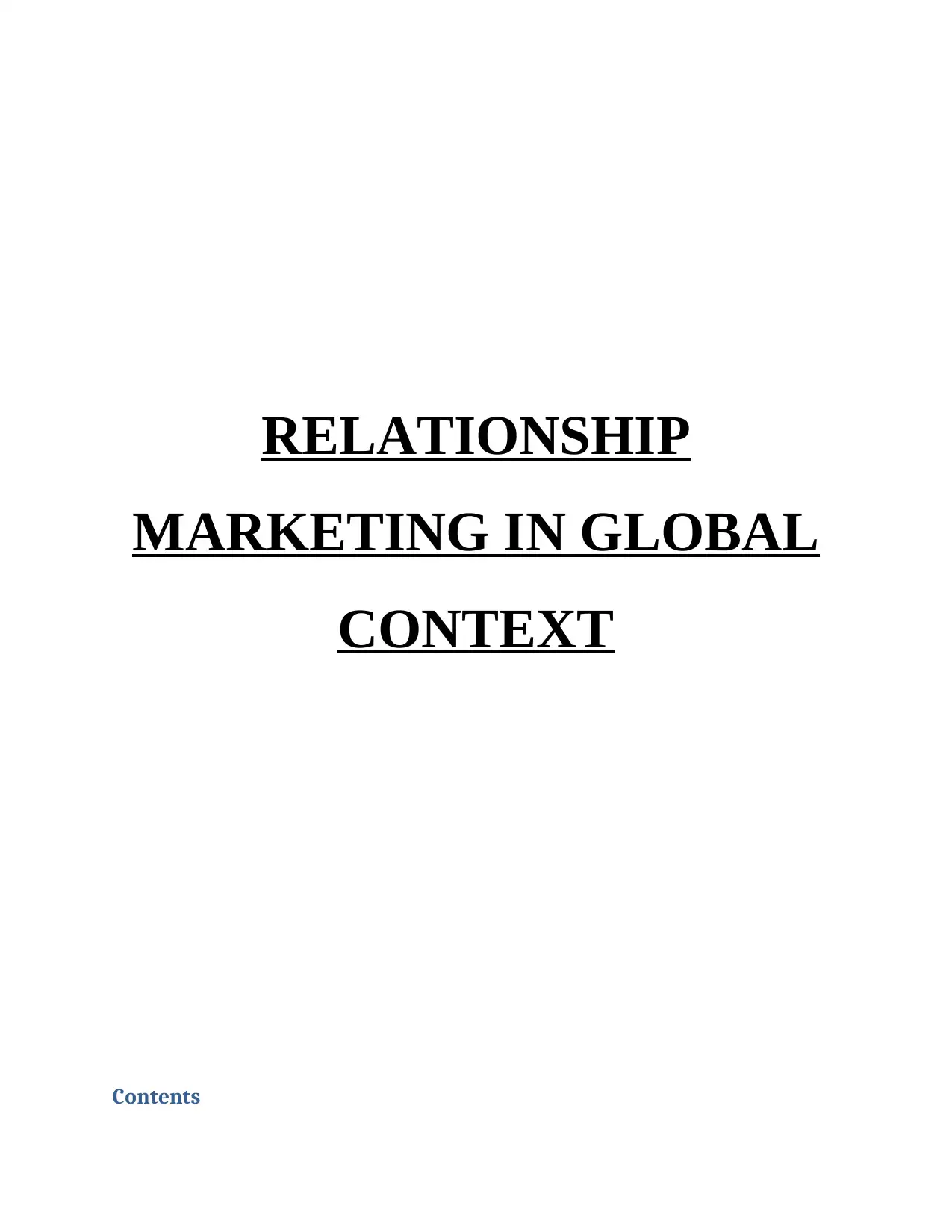
RELATIONSHIP
MARKETING IN GLOBAL
CONTEXT
Contents
MARKETING IN GLOBAL
CONTEXT
Contents
Paraphrase This Document
Need a fresh take? Get an instant paraphrase of this document with our AI Paraphraser
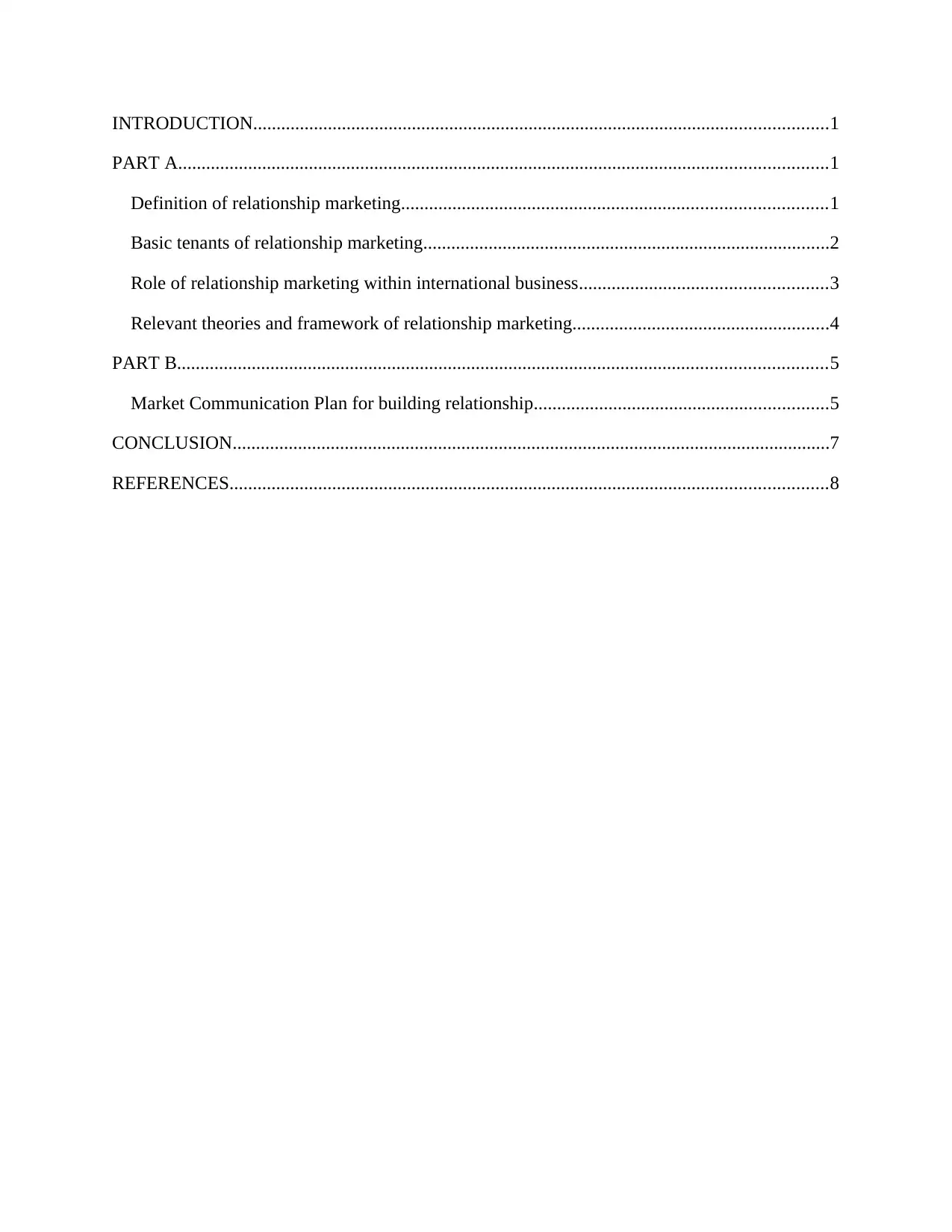
INTRODUCTION...........................................................................................................................1
PART A...........................................................................................................................................1
Definition of relationship marketing...........................................................................................1
Basic tenants of relationship marketing.......................................................................................2
Role of relationship marketing within international business.....................................................3
Relevant theories and framework of relationship marketing.......................................................4
PART B...........................................................................................................................................5
Market Communication Plan for building relationship...............................................................5
CONCLUSION................................................................................................................................7
REFERENCES................................................................................................................................8
PART A...........................................................................................................................................1
Definition of relationship marketing...........................................................................................1
Basic tenants of relationship marketing.......................................................................................2
Role of relationship marketing within international business.....................................................3
Relevant theories and framework of relationship marketing.......................................................4
PART B...........................................................................................................................................5
Market Communication Plan for building relationship...............................................................5
CONCLUSION................................................................................................................................7
REFERENCES................................................................................................................................8
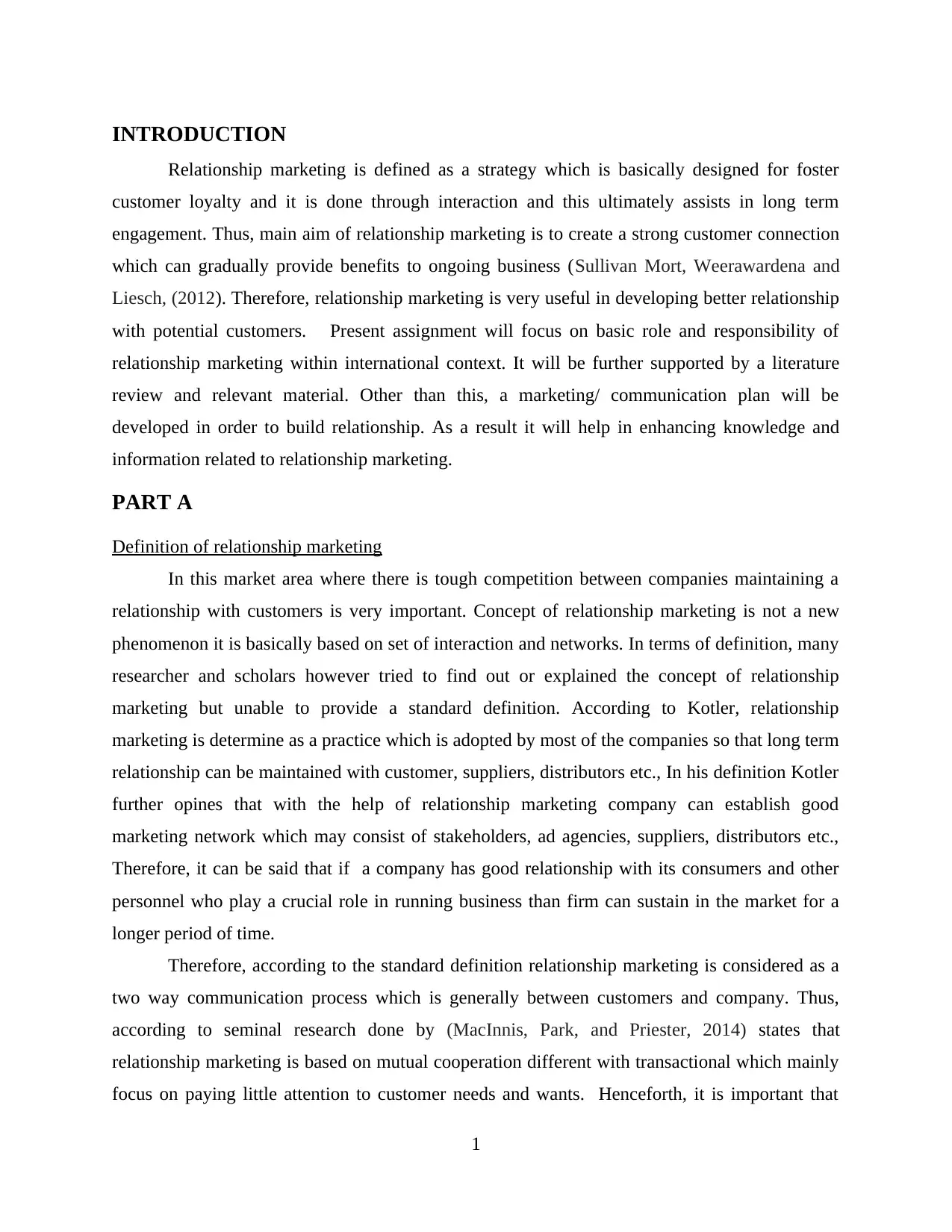
INTRODUCTION
Relationship marketing is defined as a strategy which is basically designed for foster
customer loyalty and it is done through interaction and this ultimately assists in long term
engagement. Thus, main aim of relationship marketing is to create a strong customer connection
which can gradually provide benefits to ongoing business (Sullivan Mort, Weerawardena and
Liesch, (2012). Therefore, relationship marketing is very useful in developing better relationship
with potential customers. Present assignment will focus on basic role and responsibility of
relationship marketing within international context. It will be further supported by a literature
review and relevant material. Other than this, a marketing/ communication plan will be
developed in order to build relationship. As a result it will help in enhancing knowledge and
information related to relationship marketing.
PART A
Definition of relationship marketing
In this market area where there is tough competition between companies maintaining a
relationship with customers is very important. Concept of relationship marketing is not a new
phenomenon it is basically based on set of interaction and networks. In terms of definition, many
researcher and scholars however tried to find out or explained the concept of relationship
marketing but unable to provide a standard definition. According to Kotler, relationship
marketing is determine as a practice which is adopted by most of the companies so that long term
relationship can be maintained with customer, suppliers, distributors etc., In his definition Kotler
further opines that with the help of relationship marketing company can establish good
marketing network which may consist of stakeholders, ad agencies, suppliers, distributors etc.,
Therefore, it can be said that if a company has good relationship with its consumers and other
personnel who play a crucial role in running business than firm can sustain in the market for a
longer period of time.
Therefore, according to the standard definition relationship marketing is considered as a
two way communication process which is generally between customers and company. Thus,
according to seminal research done by (MacInnis, Park, and Priester, 2014) states that
relationship marketing is based on mutual cooperation different with transactional which mainly
focus on paying little attention to customer needs and wants. Henceforth, it is important that
1
Relationship marketing is defined as a strategy which is basically designed for foster
customer loyalty and it is done through interaction and this ultimately assists in long term
engagement. Thus, main aim of relationship marketing is to create a strong customer connection
which can gradually provide benefits to ongoing business (Sullivan Mort, Weerawardena and
Liesch, (2012). Therefore, relationship marketing is very useful in developing better relationship
with potential customers. Present assignment will focus on basic role and responsibility of
relationship marketing within international context. It will be further supported by a literature
review and relevant material. Other than this, a marketing/ communication plan will be
developed in order to build relationship. As a result it will help in enhancing knowledge and
information related to relationship marketing.
PART A
Definition of relationship marketing
In this market area where there is tough competition between companies maintaining a
relationship with customers is very important. Concept of relationship marketing is not a new
phenomenon it is basically based on set of interaction and networks. In terms of definition, many
researcher and scholars however tried to find out or explained the concept of relationship
marketing but unable to provide a standard definition. According to Kotler, relationship
marketing is determine as a practice which is adopted by most of the companies so that long term
relationship can be maintained with customer, suppliers, distributors etc., In his definition Kotler
further opines that with the help of relationship marketing company can establish good
marketing network which may consist of stakeholders, ad agencies, suppliers, distributors etc.,
Therefore, it can be said that if a company has good relationship with its consumers and other
personnel who play a crucial role in running business than firm can sustain in the market for a
longer period of time.
Therefore, according to the standard definition relationship marketing is considered as a
two way communication process which is generally between customers and company. Thus,
according to seminal research done by (MacInnis, Park, and Priester, 2014) states that
relationship marketing is based on mutual cooperation different with transactional which mainly
focus on paying little attention to customer needs and wants. Henceforth, it is important that
1
⊘ This is a preview!⊘
Do you want full access?
Subscribe today to unlock all pages.

Trusted by 1+ million students worldwide
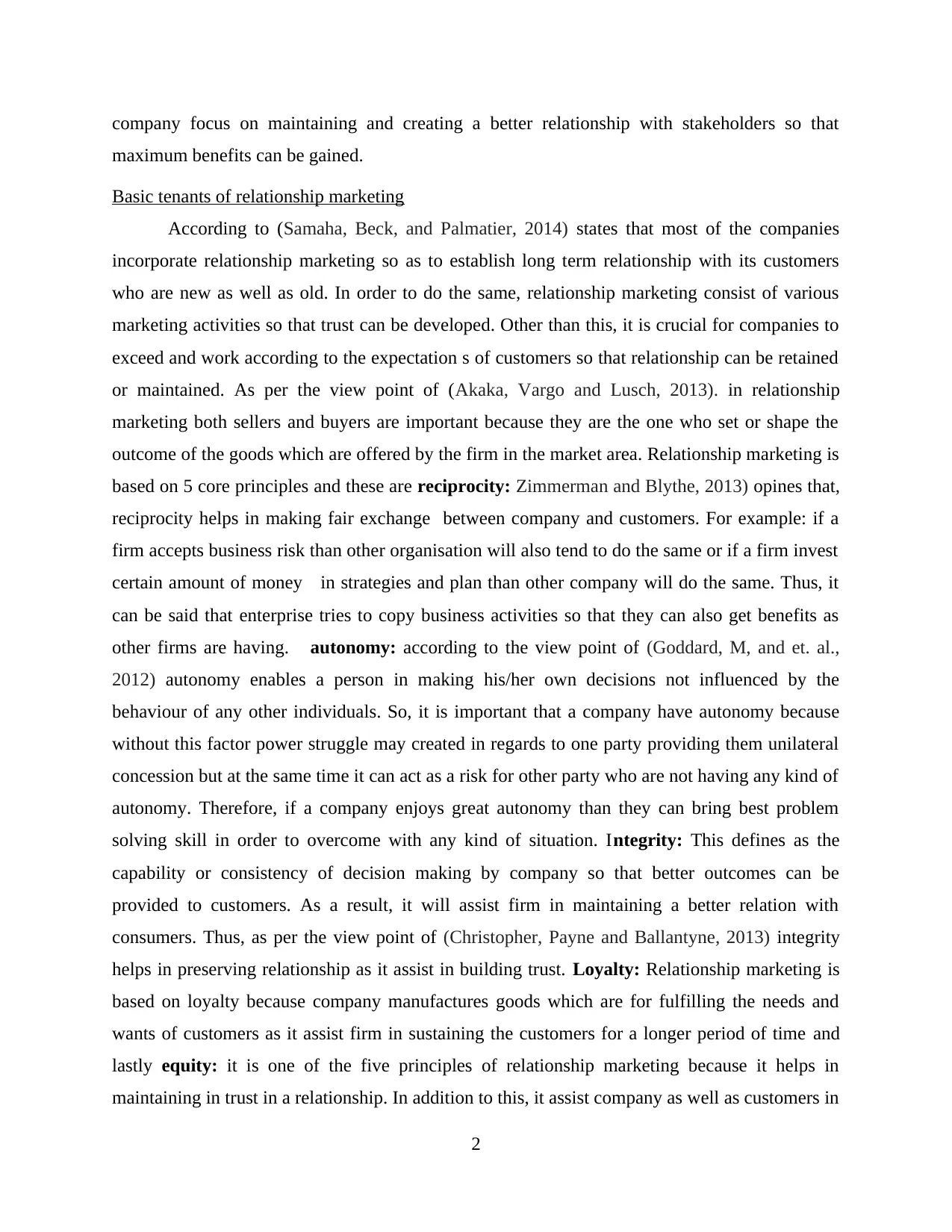
company focus on maintaining and creating a better relationship with stakeholders so that
maximum benefits can be gained.
Basic tenants of relationship marketing
According to (Samaha, Beck, and Palmatier, 2014) states that most of the companies
incorporate relationship marketing so as to establish long term relationship with its customers
who are new as well as old. In order to do the same, relationship marketing consist of various
marketing activities so that trust can be developed. Other than this, it is crucial for companies to
exceed and work according to the expectation s of customers so that relationship can be retained
or maintained. As per the view point of (Akaka, Vargo and Lusch, 2013). in relationship
marketing both sellers and buyers are important because they are the one who set or shape the
outcome of the goods which are offered by the firm in the market area. Relationship marketing is
based on 5 core principles and these are reciprocity: Zimmerman and Blythe, 2013) opines that,
reciprocity helps in making fair exchange between company and customers. For example: if a
firm accepts business risk than other organisation will also tend to do the same or if a firm invest
certain amount of money in strategies and plan than other company will do the same. Thus, it
can be said that enterprise tries to copy business activities so that they can also get benefits as
other firms are having. autonomy: according to the view point of (Goddard, M, and et. al.,
2012) autonomy enables a person in making his/her own decisions not influenced by the
behaviour of any other individuals. So, it is important that a company have autonomy because
without this factor power struggle may created in regards to one party providing them unilateral
concession but at the same time it can act as a risk for other party who are not having any kind of
autonomy. Therefore, if a company enjoys great autonomy than they can bring best problem
solving skill in order to overcome with any kind of situation. Integrity: This defines as the
capability or consistency of decision making by company so that better outcomes can be
provided to customers. As a result, it will assist firm in maintaining a better relation with
consumers. Thus, as per the view point of (Christopher, Payne and Ballantyne, 2013) integrity
helps in preserving relationship as it assist in building trust. Loyalty: Relationship marketing is
based on loyalty because company manufactures goods which are for fulfilling the needs and
wants of customers as it assist firm in sustaining the customers for a longer period of time and
lastly equity: it is one of the five principles of relationship marketing because it helps in
maintaining in trust in a relationship. In addition to this, it assist company as well as customers in
2
maximum benefits can be gained.
Basic tenants of relationship marketing
According to (Samaha, Beck, and Palmatier, 2014) states that most of the companies
incorporate relationship marketing so as to establish long term relationship with its customers
who are new as well as old. In order to do the same, relationship marketing consist of various
marketing activities so that trust can be developed. Other than this, it is crucial for companies to
exceed and work according to the expectation s of customers so that relationship can be retained
or maintained. As per the view point of (Akaka, Vargo and Lusch, 2013). in relationship
marketing both sellers and buyers are important because they are the one who set or shape the
outcome of the goods which are offered by the firm in the market area. Relationship marketing is
based on 5 core principles and these are reciprocity: Zimmerman and Blythe, 2013) opines that,
reciprocity helps in making fair exchange between company and customers. For example: if a
firm accepts business risk than other organisation will also tend to do the same or if a firm invest
certain amount of money in strategies and plan than other company will do the same. Thus, it
can be said that enterprise tries to copy business activities so that they can also get benefits as
other firms are having. autonomy: according to the view point of (Goddard, M, and et. al.,
2012) autonomy enables a person in making his/her own decisions not influenced by the
behaviour of any other individuals. So, it is important that a company have autonomy because
without this factor power struggle may created in regards to one party providing them unilateral
concession but at the same time it can act as a risk for other party who are not having any kind of
autonomy. Therefore, if a company enjoys great autonomy than they can bring best problem
solving skill in order to overcome with any kind of situation. Integrity: This defines as the
capability or consistency of decision making by company so that better outcomes can be
provided to customers. As a result, it will assist firm in maintaining a better relation with
consumers. Thus, as per the view point of (Christopher, Payne and Ballantyne, 2013) integrity
helps in preserving relationship as it assist in building trust. Loyalty: Relationship marketing is
based on loyalty because company manufactures goods which are for fulfilling the needs and
wants of customers as it assist firm in sustaining the customers for a longer period of time and
lastly equity: it is one of the five principles of relationship marketing because it helps in
maintaining in trust in a relationship. In addition to this, it assist company as well as customers in
2
Paraphrase This Document
Need a fresh take? Get an instant paraphrase of this document with our AI Paraphraser
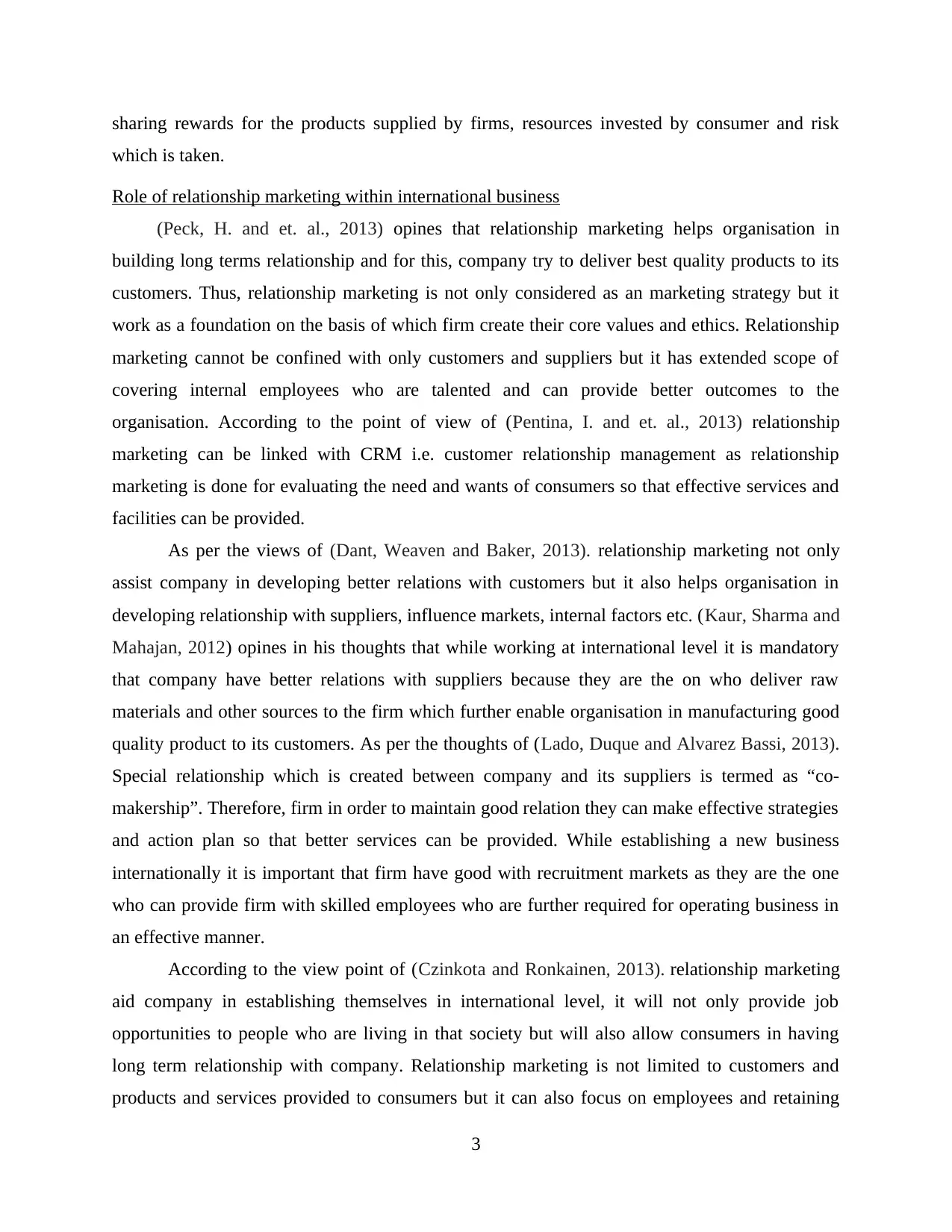
sharing rewards for the products supplied by firms, resources invested by consumer and risk
which is taken.
Role of relationship marketing within international business
(Peck, H. and et. al., 2013) opines that relationship marketing helps organisation in
building long terms relationship and for this, company try to deliver best quality products to its
customers. Thus, relationship marketing is not only considered as an marketing strategy but it
work as a foundation on the basis of which firm create their core values and ethics. Relationship
marketing cannot be confined with only customers and suppliers but it has extended scope of
covering internal employees who are talented and can provide better outcomes to the
organisation. According to the point of view of (Pentina, I. and et. al., 2013) relationship
marketing can be linked with CRM i.e. customer relationship management as relationship
marketing is done for evaluating the need and wants of consumers so that effective services and
facilities can be provided.
As per the views of (Dant, Weaven and Baker, 2013). relationship marketing not only
assist company in developing better relations with customers but it also helps organisation in
developing relationship with suppliers, influence markets, internal factors etc. (Kaur, Sharma and
Mahajan, 2012) opines in his thoughts that while working at international level it is mandatory
that company have better relations with suppliers because they are the on who deliver raw
materials and other sources to the firm which further enable organisation in manufacturing good
quality product to its customers. As per the thoughts of (Lado, Duque and Alvarez Bassi, 2013).
Special relationship which is created between company and its suppliers is termed as “co-
makership”. Therefore, firm in order to maintain good relation they can make effective strategies
and action plan so that better services can be provided. While establishing a new business
internationally it is important that firm have good with recruitment markets as they are the one
who can provide firm with skilled employees who are further required for operating business in
an effective manner.
According to the view point of (Czinkota and Ronkainen, 2013). relationship marketing
aid company in establishing themselves in international level, it will not only provide job
opportunities to people who are living in that society but will also allow consumers in having
long term relationship with company. Relationship marketing is not limited to customers and
products and services provided to consumers but it can also focus on employees and retaining
3
which is taken.
Role of relationship marketing within international business
(Peck, H. and et. al., 2013) opines that relationship marketing helps organisation in
building long terms relationship and for this, company try to deliver best quality products to its
customers. Thus, relationship marketing is not only considered as an marketing strategy but it
work as a foundation on the basis of which firm create their core values and ethics. Relationship
marketing cannot be confined with only customers and suppliers but it has extended scope of
covering internal employees who are talented and can provide better outcomes to the
organisation. According to the point of view of (Pentina, I. and et. al., 2013) relationship
marketing can be linked with CRM i.e. customer relationship management as relationship
marketing is done for evaluating the need and wants of consumers so that effective services and
facilities can be provided.
As per the views of (Dant, Weaven and Baker, 2013). relationship marketing not only
assist company in developing better relations with customers but it also helps organisation in
developing relationship with suppliers, influence markets, internal factors etc. (Kaur, Sharma and
Mahajan, 2012) opines in his thoughts that while working at international level it is mandatory
that company have better relations with suppliers because they are the on who deliver raw
materials and other sources to the firm which further enable organisation in manufacturing good
quality product to its customers. As per the thoughts of (Lado, Duque and Alvarez Bassi, 2013).
Special relationship which is created between company and its suppliers is termed as “co-
makership”. Therefore, firm in order to maintain good relation they can make effective strategies
and action plan so that better services can be provided. While establishing a new business
internationally it is important that firm have good with recruitment markets as they are the one
who can provide firm with skilled employees who are further required for operating business in
an effective manner.
According to the view point of (Czinkota and Ronkainen, 2013). relationship marketing
aid company in establishing themselves in international level, it will not only provide job
opportunities to people who are living in that society but will also allow consumers in having
long term relationship with company. Relationship marketing is not limited to customers and
products and services provided to consumers but it can also focus on employees and retaining
3
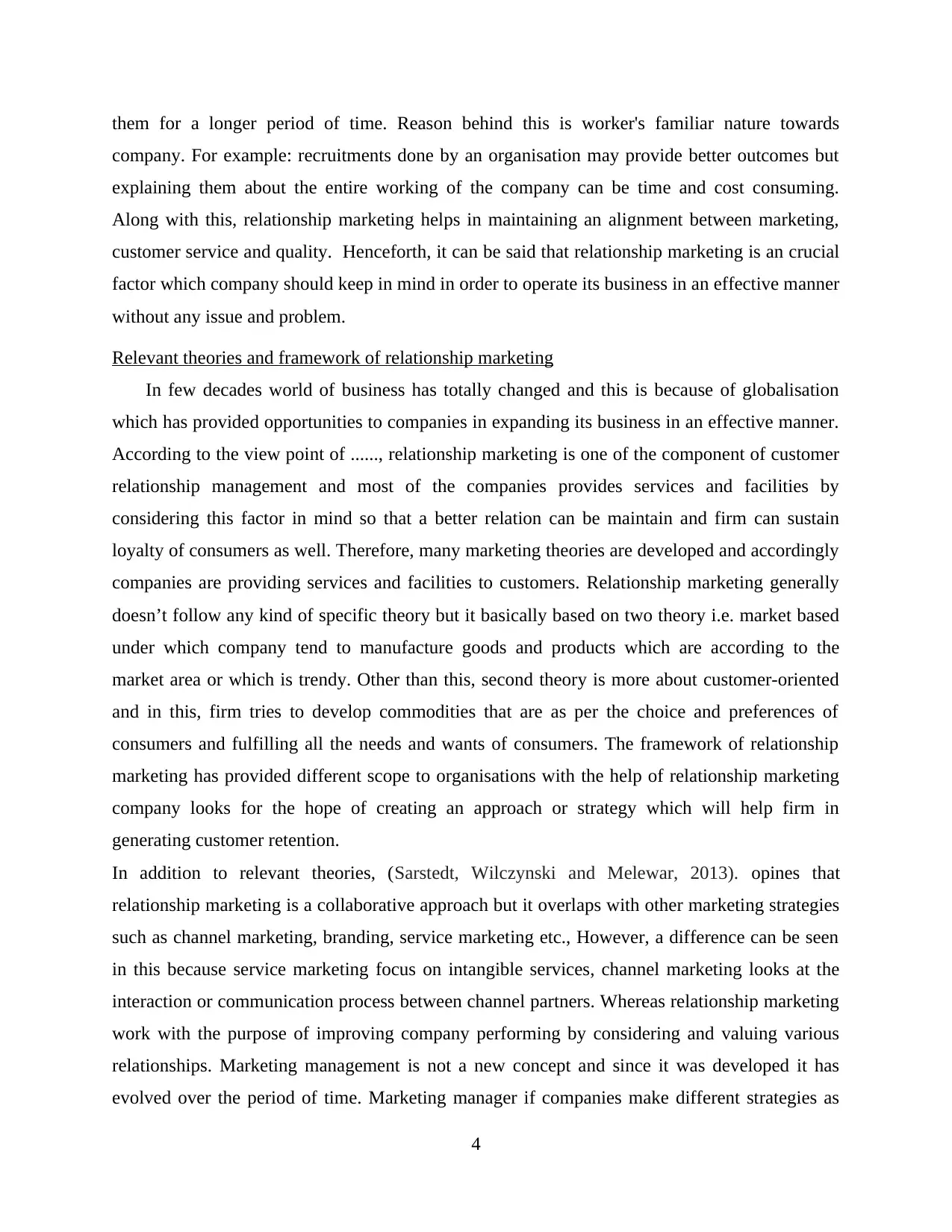
them for a longer period of time. Reason behind this is worker's familiar nature towards
company. For example: recruitments done by an organisation may provide better outcomes but
explaining them about the entire working of the company can be time and cost consuming.
Along with this, relationship marketing helps in maintaining an alignment between marketing,
customer service and quality. Henceforth, it can be said that relationship marketing is an crucial
factor which company should keep in mind in order to operate its business in an effective manner
without any issue and problem.
Relevant theories and framework of relationship marketing
In few decades world of business has totally changed and this is because of globalisation
which has provided opportunities to companies in expanding its business in an effective manner.
According to the view point of ......, relationship marketing is one of the component of customer
relationship management and most of the companies provides services and facilities by
considering this factor in mind so that a better relation can be maintain and firm can sustain
loyalty of consumers as well. Therefore, many marketing theories are developed and accordingly
companies are providing services and facilities to customers. Relationship marketing generally
doesn’t follow any kind of specific theory but it basically based on two theory i.e. market based
under which company tend to manufacture goods and products which are according to the
market area or which is trendy. Other than this, second theory is more about customer-oriented
and in this, firm tries to develop commodities that are as per the choice and preferences of
consumers and fulfilling all the needs and wants of consumers. The framework of relationship
marketing has provided different scope to organisations with the help of relationship marketing
company looks for the hope of creating an approach or strategy which will help firm in
generating customer retention.
In addition to relevant theories, (Sarstedt, Wilczynski and Melewar, 2013). opines that
relationship marketing is a collaborative approach but it overlaps with other marketing strategies
such as channel marketing, branding, service marketing etc., However, a difference can be seen
in this because service marketing focus on intangible services, channel marketing looks at the
interaction or communication process between channel partners. Whereas relationship marketing
work with the purpose of improving company performing by considering and valuing various
relationships. Marketing management is not a new concept and since it was developed it has
evolved over the period of time. Marketing manager if companies make different strategies as
4
company. For example: recruitments done by an organisation may provide better outcomes but
explaining them about the entire working of the company can be time and cost consuming.
Along with this, relationship marketing helps in maintaining an alignment between marketing,
customer service and quality. Henceforth, it can be said that relationship marketing is an crucial
factor which company should keep in mind in order to operate its business in an effective manner
without any issue and problem.
Relevant theories and framework of relationship marketing
In few decades world of business has totally changed and this is because of globalisation
which has provided opportunities to companies in expanding its business in an effective manner.
According to the view point of ......, relationship marketing is one of the component of customer
relationship management and most of the companies provides services and facilities by
considering this factor in mind so that a better relation can be maintain and firm can sustain
loyalty of consumers as well. Therefore, many marketing theories are developed and accordingly
companies are providing services and facilities to customers. Relationship marketing generally
doesn’t follow any kind of specific theory but it basically based on two theory i.e. market based
under which company tend to manufacture goods and products which are according to the
market area or which is trendy. Other than this, second theory is more about customer-oriented
and in this, firm tries to develop commodities that are as per the choice and preferences of
consumers and fulfilling all the needs and wants of consumers. The framework of relationship
marketing has provided different scope to organisations with the help of relationship marketing
company looks for the hope of creating an approach or strategy which will help firm in
generating customer retention.
In addition to relevant theories, (Sarstedt, Wilczynski and Melewar, 2013). opines that
relationship marketing is a collaborative approach but it overlaps with other marketing strategies
such as channel marketing, branding, service marketing etc., However, a difference can be seen
in this because service marketing focus on intangible services, channel marketing looks at the
interaction or communication process between channel partners. Whereas relationship marketing
work with the purpose of improving company performing by considering and valuing various
relationships. Marketing management is not a new concept and since it was developed it has
evolved over the period of time. Marketing manager if companies make different strategies as
4
⊘ This is a preview!⊘
Do you want full access?
Subscribe today to unlock all pages.

Trusted by 1+ million students worldwide
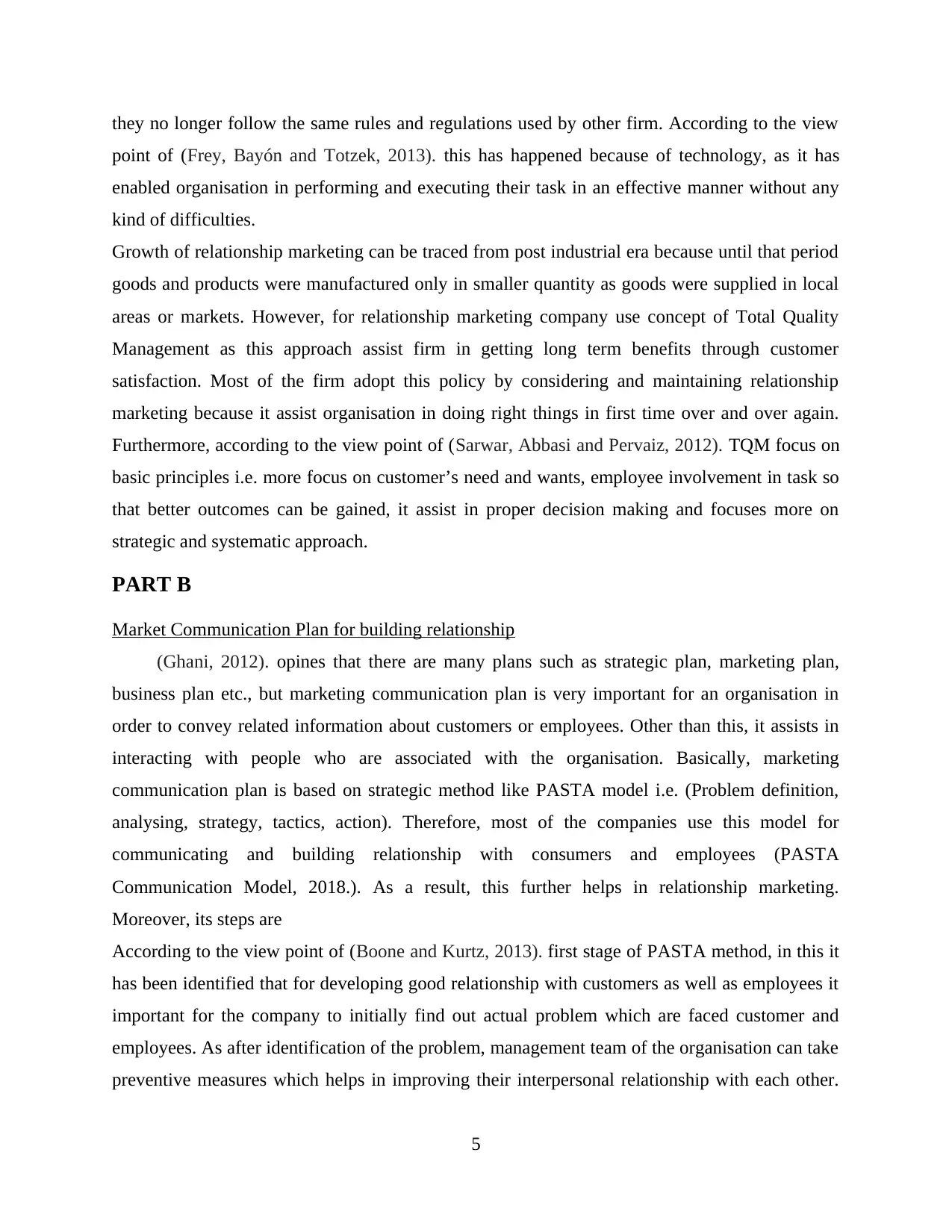
they no longer follow the same rules and regulations used by other firm. According to the view
point of (Frey, Bayón and Totzek, 2013). this has happened because of technology, as it has
enabled organisation in performing and executing their task in an effective manner without any
kind of difficulties.
Growth of relationship marketing can be traced from post industrial era because until that period
goods and products were manufactured only in smaller quantity as goods were supplied in local
areas or markets. However, for relationship marketing company use concept of Total Quality
Management as this approach assist firm in getting long term benefits through customer
satisfaction. Most of the firm adopt this policy by considering and maintaining relationship
marketing because it assist organisation in doing right things in first time over and over again.
Furthermore, according to the view point of (Sarwar, Abbasi and Pervaiz, 2012). TQM focus on
basic principles i.e. more focus on customer’s need and wants, employee involvement in task so
that better outcomes can be gained, it assist in proper decision making and focuses more on
strategic and systematic approach.
PART B
Market Communication Plan for building relationship
(Ghani, 2012). opines that there are many plans such as strategic plan, marketing plan,
business plan etc., but marketing communication plan is very important for an organisation in
order to convey related information about customers or employees. Other than this, it assists in
interacting with people who are associated with the organisation. Basically, marketing
communication plan is based on strategic method like PASTA model i.e. (Problem definition,
analysing, strategy, tactics, action). Therefore, most of the companies use this model for
communicating and building relationship with consumers and employees (PASTA
Communication Model, 2018.). As a result, this further helps in relationship marketing.
Moreover, its steps are
According to the view point of (Boone and Kurtz, 2013). first stage of PASTA method, in this it
has been identified that for developing good relationship with customers as well as employees it
important for the company to initially find out actual problem which are faced customer and
employees. As after identification of the problem, management team of the organisation can take
preventive measures which helps in improving their interpersonal relationship with each other.
5
point of (Frey, Bayón and Totzek, 2013). this has happened because of technology, as it has
enabled organisation in performing and executing their task in an effective manner without any
kind of difficulties.
Growth of relationship marketing can be traced from post industrial era because until that period
goods and products were manufactured only in smaller quantity as goods were supplied in local
areas or markets. However, for relationship marketing company use concept of Total Quality
Management as this approach assist firm in getting long term benefits through customer
satisfaction. Most of the firm adopt this policy by considering and maintaining relationship
marketing because it assist organisation in doing right things in first time over and over again.
Furthermore, according to the view point of (Sarwar, Abbasi and Pervaiz, 2012). TQM focus on
basic principles i.e. more focus on customer’s need and wants, employee involvement in task so
that better outcomes can be gained, it assist in proper decision making and focuses more on
strategic and systematic approach.
PART B
Market Communication Plan for building relationship
(Ghani, 2012). opines that there are many plans such as strategic plan, marketing plan,
business plan etc., but marketing communication plan is very important for an organisation in
order to convey related information about customers or employees. Other than this, it assists in
interacting with people who are associated with the organisation. Basically, marketing
communication plan is based on strategic method like PASTA model i.e. (Problem definition,
analysing, strategy, tactics, action). Therefore, most of the companies use this model for
communicating and building relationship with consumers and employees (PASTA
Communication Model, 2018.). As a result, this further helps in relationship marketing.
Moreover, its steps are
According to the view point of (Boone and Kurtz, 2013). first stage of PASTA method, in this it
has been identified that for developing good relationship with customers as well as employees it
important for the company to initially find out actual problem which are faced customer and
employees. As after identification of the problem, management team of the organisation can take
preventive measures which helps in improving their interpersonal relationship with each other.
5
Paraphrase This Document
Need a fresh take? Get an instant paraphrase of this document with our AI Paraphraser
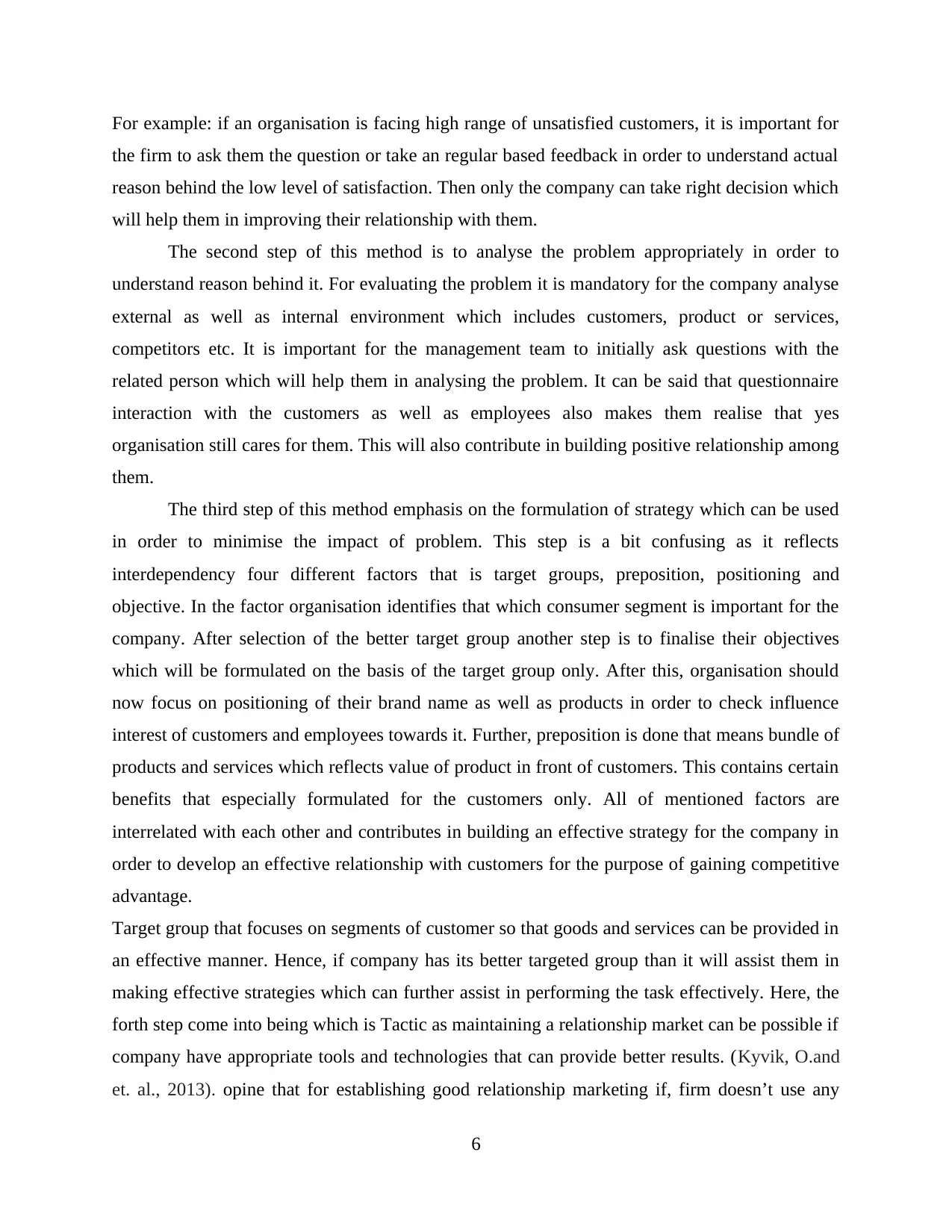
For example: if an organisation is facing high range of unsatisfied customers, it is important for
the firm to ask them the question or take an regular based feedback in order to understand actual
reason behind the low level of satisfaction. Then only the company can take right decision which
will help them in improving their relationship with them.
The second step of this method is to analyse the problem appropriately in order to
understand reason behind it. For evaluating the problem it is mandatory for the company analyse
external as well as internal environment which includes customers, product or services,
competitors etc. It is important for the management team to initially ask questions with the
related person which will help them in analysing the problem. It can be said that questionnaire
interaction with the customers as well as employees also makes them realise that yes
organisation still cares for them. This will also contribute in building positive relationship among
them.
The third step of this method emphasis on the formulation of strategy which can be used
in order to minimise the impact of problem. This step is a bit confusing as it reflects
interdependency four different factors that is target groups, preposition, positioning and
objective. In the factor organisation identifies that which consumer segment is important for the
company. After selection of the better target group another step is to finalise their objectives
which will be formulated on the basis of the target group only. After this, organisation should
now focus on positioning of their brand name as well as products in order to check influence
interest of customers and employees towards it. Further, preposition is done that means bundle of
products and services which reflects value of product in front of customers. This contains certain
benefits that especially formulated for the customers only. All of mentioned factors are
interrelated with each other and contributes in building an effective strategy for the company in
order to develop an effective relationship with customers for the purpose of gaining competitive
advantage.
Target group that focuses on segments of customer so that goods and services can be provided in
an effective manner. Hence, if company has its better targeted group than it will assist them in
making effective strategies which can further assist in performing the task effectively. Here, the
forth step come into being which is Tactic as maintaining a relationship market can be possible if
company have appropriate tools and technologies that can provide better results. (Kyvik, O.and
et. al., 2013). opine that for establishing good relationship marketing if, firm doesn’t use any
6
the firm to ask them the question or take an regular based feedback in order to understand actual
reason behind the low level of satisfaction. Then only the company can take right decision which
will help them in improving their relationship with them.
The second step of this method is to analyse the problem appropriately in order to
understand reason behind it. For evaluating the problem it is mandatory for the company analyse
external as well as internal environment which includes customers, product or services,
competitors etc. It is important for the management team to initially ask questions with the
related person which will help them in analysing the problem. It can be said that questionnaire
interaction with the customers as well as employees also makes them realise that yes
organisation still cares for them. This will also contribute in building positive relationship among
them.
The third step of this method emphasis on the formulation of strategy which can be used
in order to minimise the impact of problem. This step is a bit confusing as it reflects
interdependency four different factors that is target groups, preposition, positioning and
objective. In the factor organisation identifies that which consumer segment is important for the
company. After selection of the better target group another step is to finalise their objectives
which will be formulated on the basis of the target group only. After this, organisation should
now focus on positioning of their brand name as well as products in order to check influence
interest of customers and employees towards it. Further, preposition is done that means bundle of
products and services which reflects value of product in front of customers. This contains certain
benefits that especially formulated for the customers only. All of mentioned factors are
interrelated with each other and contributes in building an effective strategy for the company in
order to develop an effective relationship with customers for the purpose of gaining competitive
advantage.
Target group that focuses on segments of customer so that goods and services can be provided in
an effective manner. Hence, if company has its better targeted group than it will assist them in
making effective strategies which can further assist in performing the task effectively. Here, the
forth step come into being which is Tactic as maintaining a relationship market can be possible if
company have appropriate tools and technologies that can provide better results. (Kyvik, O.and
et. al., 2013). opine that for establishing good relationship marketing if, firm doesn’t use any
6
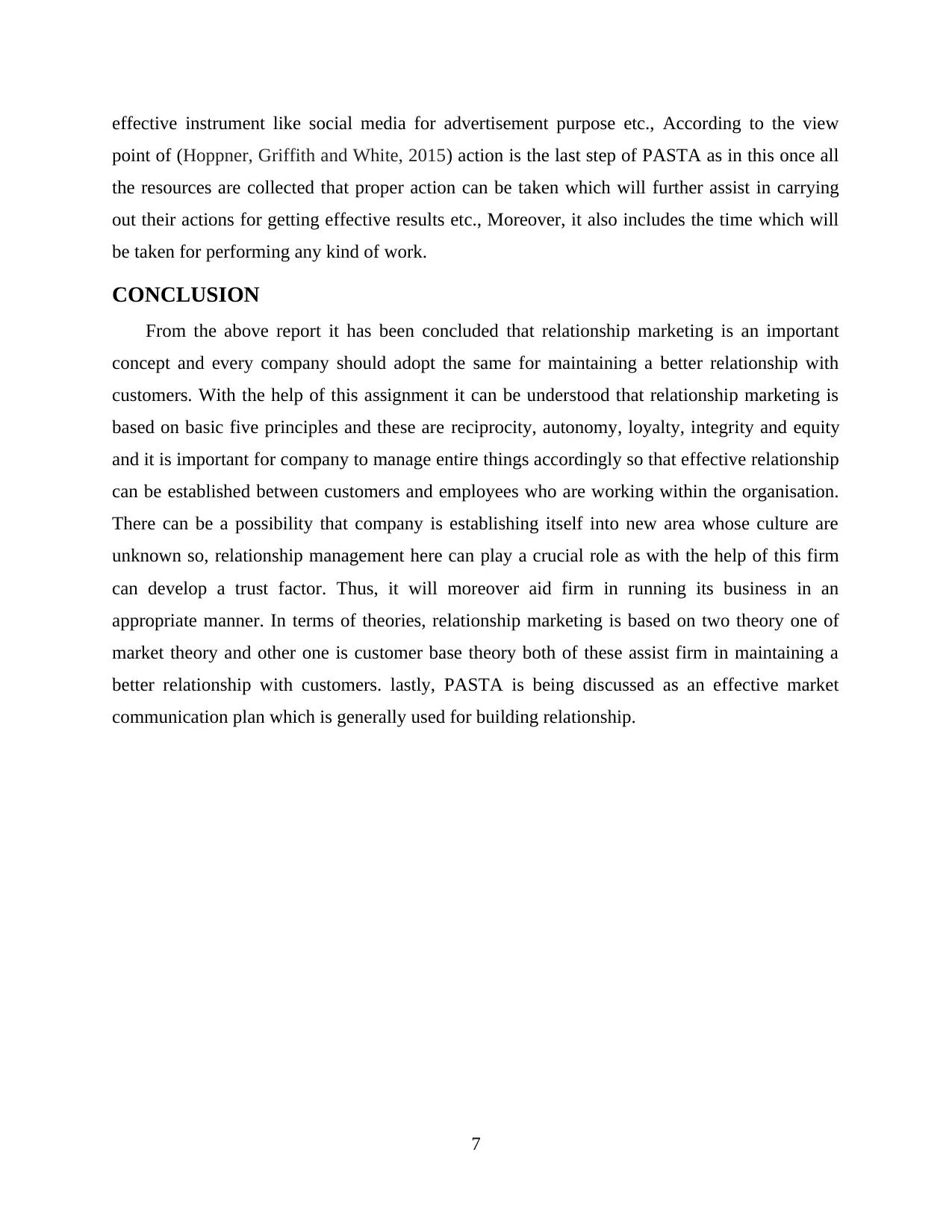
effective instrument like social media for advertisement purpose etc., According to the view
point of (Hoppner, Griffith and White, 2015) action is the last step of PASTA as in this once all
the resources are collected that proper action can be taken which will further assist in carrying
out their actions for getting effective results etc., Moreover, it also includes the time which will
be taken for performing any kind of work.
CONCLUSION
From the above report it has been concluded that relationship marketing is an important
concept and every company should adopt the same for maintaining a better relationship with
customers. With the help of this assignment it can be understood that relationship marketing is
based on basic five principles and these are reciprocity, autonomy, loyalty, integrity and equity
and it is important for company to manage entire things accordingly so that effective relationship
can be established between customers and employees who are working within the organisation.
There can be a possibility that company is establishing itself into new area whose culture are
unknown so, relationship management here can play a crucial role as with the help of this firm
can develop a trust factor. Thus, it will moreover aid firm in running its business in an
appropriate manner. In terms of theories, relationship marketing is based on two theory one of
market theory and other one is customer base theory both of these assist firm in maintaining a
better relationship with customers. lastly, PASTA is being discussed as an effective market
communication plan which is generally used for building relationship.
7
point of (Hoppner, Griffith and White, 2015) action is the last step of PASTA as in this once all
the resources are collected that proper action can be taken which will further assist in carrying
out their actions for getting effective results etc., Moreover, it also includes the time which will
be taken for performing any kind of work.
CONCLUSION
From the above report it has been concluded that relationship marketing is an important
concept and every company should adopt the same for maintaining a better relationship with
customers. With the help of this assignment it can be understood that relationship marketing is
based on basic five principles and these are reciprocity, autonomy, loyalty, integrity and equity
and it is important for company to manage entire things accordingly so that effective relationship
can be established between customers and employees who are working within the organisation.
There can be a possibility that company is establishing itself into new area whose culture are
unknown so, relationship management here can play a crucial role as with the help of this firm
can develop a trust factor. Thus, it will moreover aid firm in running its business in an
appropriate manner. In terms of theories, relationship marketing is based on two theory one of
market theory and other one is customer base theory both of these assist firm in maintaining a
better relationship with customers. lastly, PASTA is being discussed as an effective market
communication plan which is generally used for building relationship.
7
⊘ This is a preview!⊘
Do you want full access?
Subscribe today to unlock all pages.

Trusted by 1+ million students worldwide
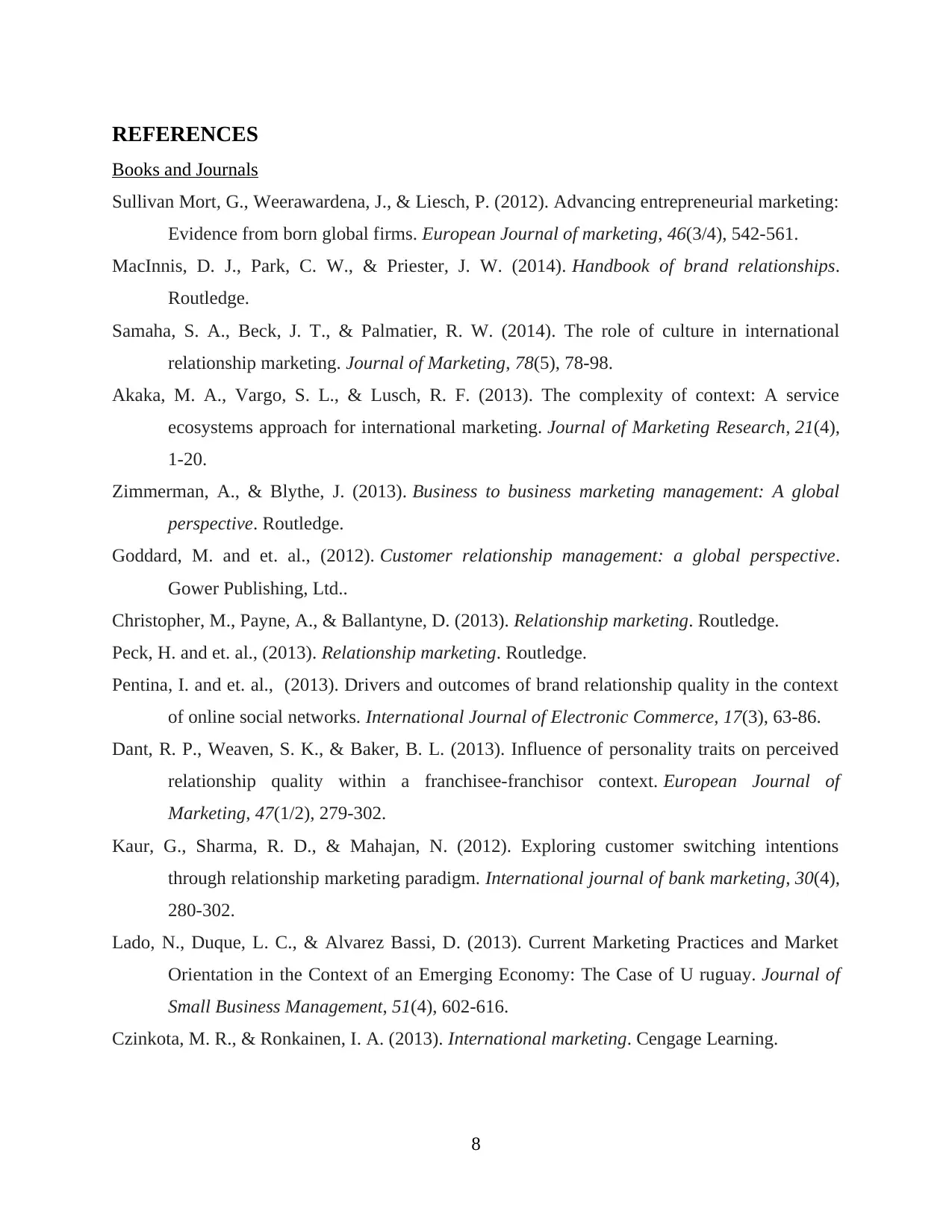
REFERENCES
Books and Journals
Sullivan Mort, G., Weerawardena, J., & Liesch, P. (2012). Advancing entrepreneurial marketing:
Evidence from born global firms. European Journal of marketing, 46(3/4), 542-561.
MacInnis, D. J., Park, C. W., & Priester, J. W. (2014). Handbook of brand relationships.
Routledge.
Samaha, S. A., Beck, J. T., & Palmatier, R. W. (2014). The role of culture in international
relationship marketing. Journal of Marketing, 78(5), 78-98.
Akaka, M. A., Vargo, S. L., & Lusch, R. F. (2013). The complexity of context: A service
ecosystems approach for international marketing. Journal of Marketing Research, 21(4),
1-20.
Zimmerman, A., & Blythe, J. (2013). Business to business marketing management: A global
perspective. Routledge.
Goddard, M. and et. al., (2012). Customer relationship management: a global perspective.
Gower Publishing, Ltd..
Christopher, M., Payne, A., & Ballantyne, D. (2013). Relationship marketing. Routledge.
Peck, H. and et. al., (2013). Relationship marketing. Routledge.
Pentina, I. and et. al., (2013). Drivers and outcomes of brand relationship quality in the context
of online social networks. International Journal of Electronic Commerce, 17(3), 63-86.
Dant, R. P., Weaven, S. K., & Baker, B. L. (2013). Influence of personality traits on perceived
relationship quality within a franchisee-franchisor context. European Journal of
Marketing, 47(1/2), 279-302.
Kaur, G., Sharma, R. D., & Mahajan, N. (2012). Exploring customer switching intentions
through relationship marketing paradigm. International journal of bank marketing, 30(4),
280-302.
Lado, N., Duque, L. C., & Alvarez Bassi, D. (2013). Current Marketing Practices and Market
Orientation in the Context of an Emerging Economy: The Case of U ruguay. Journal of
Small Business Management, 51(4), 602-616.
Czinkota, M. R., & Ronkainen, I. A. (2013). International marketing. Cengage Learning.
8
Books and Journals
Sullivan Mort, G., Weerawardena, J., & Liesch, P. (2012). Advancing entrepreneurial marketing:
Evidence from born global firms. European Journal of marketing, 46(3/4), 542-561.
MacInnis, D. J., Park, C. W., & Priester, J. W. (2014). Handbook of brand relationships.
Routledge.
Samaha, S. A., Beck, J. T., & Palmatier, R. W. (2014). The role of culture in international
relationship marketing. Journal of Marketing, 78(5), 78-98.
Akaka, M. A., Vargo, S. L., & Lusch, R. F. (2013). The complexity of context: A service
ecosystems approach for international marketing. Journal of Marketing Research, 21(4),
1-20.
Zimmerman, A., & Blythe, J. (2013). Business to business marketing management: A global
perspective. Routledge.
Goddard, M. and et. al., (2012). Customer relationship management: a global perspective.
Gower Publishing, Ltd..
Christopher, M., Payne, A., & Ballantyne, D. (2013). Relationship marketing. Routledge.
Peck, H. and et. al., (2013). Relationship marketing. Routledge.
Pentina, I. and et. al., (2013). Drivers and outcomes of brand relationship quality in the context
of online social networks. International Journal of Electronic Commerce, 17(3), 63-86.
Dant, R. P., Weaven, S. K., & Baker, B. L. (2013). Influence of personality traits on perceived
relationship quality within a franchisee-franchisor context. European Journal of
Marketing, 47(1/2), 279-302.
Kaur, G., Sharma, R. D., & Mahajan, N. (2012). Exploring customer switching intentions
through relationship marketing paradigm. International journal of bank marketing, 30(4),
280-302.
Lado, N., Duque, L. C., & Alvarez Bassi, D. (2013). Current Marketing Practices and Market
Orientation in the Context of an Emerging Economy: The Case of U ruguay. Journal of
Small Business Management, 51(4), 602-616.
Czinkota, M. R., & Ronkainen, I. A. (2013). International marketing. Cengage Learning.
8
Paraphrase This Document
Need a fresh take? Get an instant paraphrase of this document with our AI Paraphraser
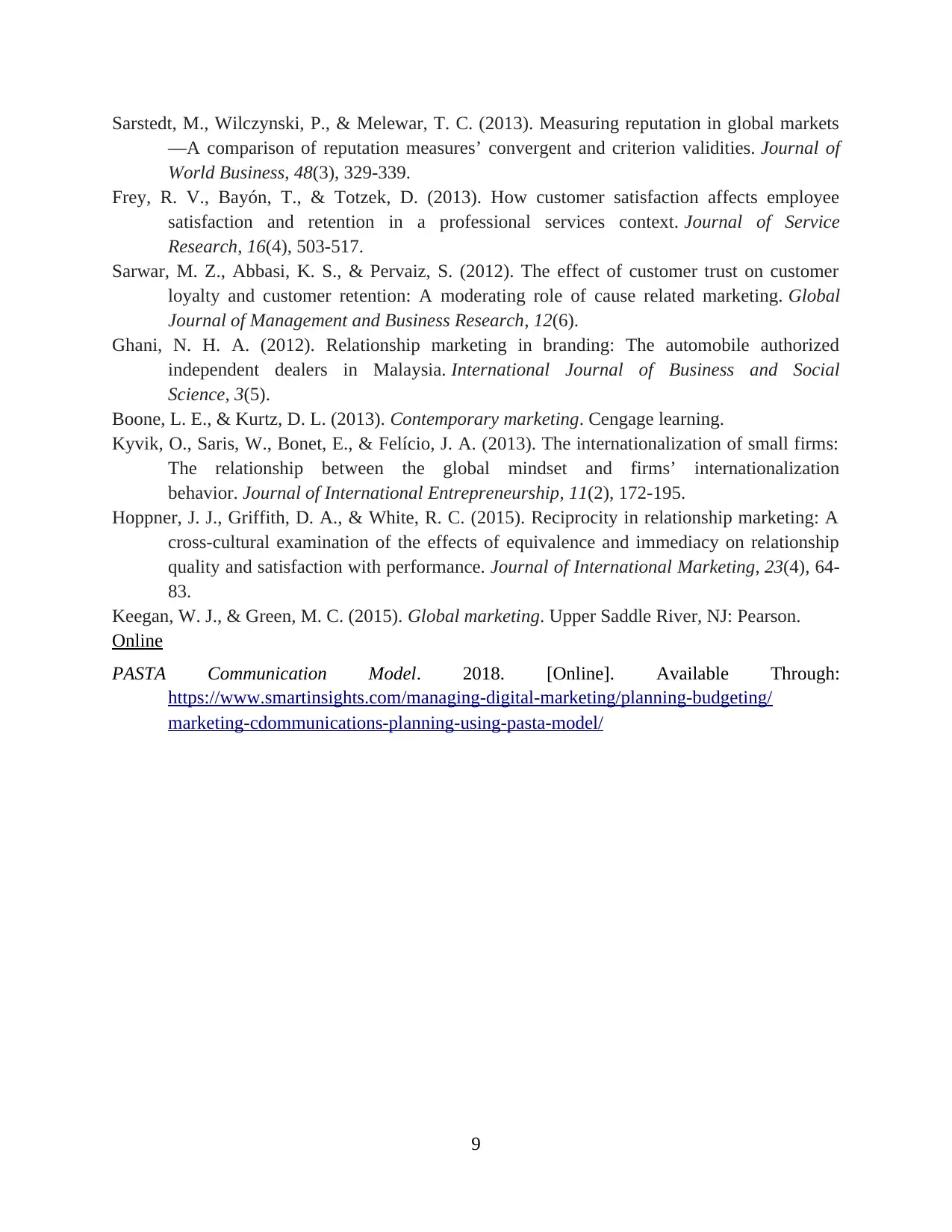
Sarstedt, M., Wilczynski, P., & Melewar, T. C. (2013). Measuring reputation in global markets
—A comparison of reputation measures’ convergent and criterion validities. Journal of
World Business, 48(3), 329-339.
Frey, R. V., Bayón, T., & Totzek, D. (2013). How customer satisfaction affects employee
satisfaction and retention in a professional services context. Journal of Service
Research, 16(4), 503-517.
Sarwar, M. Z., Abbasi, K. S., & Pervaiz, S. (2012). The effect of customer trust on customer
loyalty and customer retention: A moderating role of cause related marketing. Global
Journal of Management and Business Research, 12(6).
Ghani, N. H. A. (2012). Relationship marketing in branding: The automobile authorized
independent dealers in Malaysia. International Journal of Business and Social
Science, 3(5).
Boone, L. E., & Kurtz, D. L. (2013). Contemporary marketing. Cengage learning.
Kyvik, O., Saris, W., Bonet, E., & Felício, J. A. (2013). The internationalization of small firms:
The relationship between the global mindset and firms’ internationalization
behavior. Journal of International Entrepreneurship, 11(2), 172-195.
Hoppner, J. J., Griffith, D. A., & White, R. C. (2015). Reciprocity in relationship marketing: A
cross-cultural examination of the effects of equivalence and immediacy on relationship
quality and satisfaction with performance. Journal of International Marketing, 23(4), 64-
83.
Keegan, W. J., & Green, M. C. (2015). Global marketing. Upper Saddle River, NJ: Pearson.
Online
PASTA Communication Model. 2018. [Online]. Available Through:
https://www.smartinsights.com/managing-digital-marketing/planning-budgeting/
marketing-cdommunications-planning-using-pasta-model/
9
—A comparison of reputation measures’ convergent and criterion validities. Journal of
World Business, 48(3), 329-339.
Frey, R. V., Bayón, T., & Totzek, D. (2013). How customer satisfaction affects employee
satisfaction and retention in a professional services context. Journal of Service
Research, 16(4), 503-517.
Sarwar, M. Z., Abbasi, K. S., & Pervaiz, S. (2012). The effect of customer trust on customer
loyalty and customer retention: A moderating role of cause related marketing. Global
Journal of Management and Business Research, 12(6).
Ghani, N. H. A. (2012). Relationship marketing in branding: The automobile authorized
independent dealers in Malaysia. International Journal of Business and Social
Science, 3(5).
Boone, L. E., & Kurtz, D. L. (2013). Contemporary marketing. Cengage learning.
Kyvik, O., Saris, W., Bonet, E., & Felício, J. A. (2013). The internationalization of small firms:
The relationship between the global mindset and firms’ internationalization
behavior. Journal of International Entrepreneurship, 11(2), 172-195.
Hoppner, J. J., Griffith, D. A., & White, R. C. (2015). Reciprocity in relationship marketing: A
cross-cultural examination of the effects of equivalence and immediacy on relationship
quality and satisfaction with performance. Journal of International Marketing, 23(4), 64-
83.
Keegan, W. J., & Green, M. C. (2015). Global marketing. Upper Saddle River, NJ: Pearson.
Online
PASTA Communication Model. 2018. [Online]. Available Through:
https://www.smartinsights.com/managing-digital-marketing/planning-budgeting/
marketing-cdommunications-planning-using-pasta-model/
9
1 out of 11
Related Documents
Your All-in-One AI-Powered Toolkit for Academic Success.
+13062052269
info@desklib.com
Available 24*7 on WhatsApp / Email
![[object Object]](/_next/static/media/star-bottom.7253800d.svg)
Unlock your academic potential
Copyright © 2020–2025 A2Z Services. All Rights Reserved. Developed and managed by ZUCOL.





